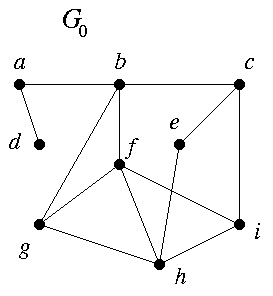
For Mon. 1/31: Read Section 1.3.
Remember to check the announcements page for corrections.
Do for discussion Tues. 2/1:
Sect. 1.1, ## 1, 2, 4(a-c), 6.
Sect. 1.2, # 1, 4, 7.
Do for discussion Wed. 2/2 Fri. 2/4 (Changed due to Wed. cancellation):
Sect. 1.1, # 9.
Sect. 1.2, ## 2, 3, 6, 8.
# C2.
Hand in Fri. 2/4 Mon. 2/7 (Changed due to Wed. cancellation):
Sect. 1.1, ## 3, 4(d), 5, 7, 8.
Sect. 1.2, # 5.
## C1, C3.

C1. This concerns Theorem 1.1.2 and the example G0. I follow the book's notation.
The sequence
(S1) (4, 4, 4, 3, 3, 3, 2, 2, 1)
is known to be graphic, because it is the degree sequence of G0. From (S1) the rule of Theorem 1.1.2 gives
(S2) (3,3,2,2,3,2,2,1),
which, when rearranged in descending order, is
(S3) (3,3,3,2,2,2,2,1).
C2. In the graph F of Figure 1.1.16:
C3. Let G be a graph which has a cycle. Let C be a cycle in G. Let a, b be arbitrary vertices in G, and let e be any edge in C. Explain in detail why, if G has a path connecting a to b, so does G - e.
A solution is available here.